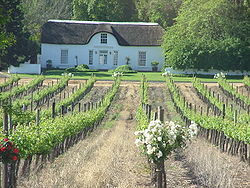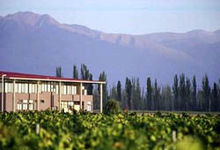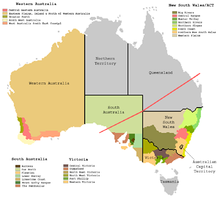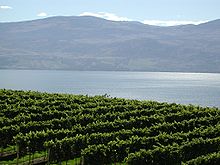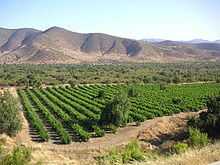- New World wine
-
Vineyard in Stellenbosch, South Africa

New World wines are those wines produced outside the traditional wine-growing areas of Europe, in particular from Argentina, Australia, Canada, Chile, New Zealand, South Africa and the United States.
Contents
History
Each of these countries have separate wine-growing heritages that go back centuries, but there are some common themes. As in 'the old country', the Church often initiated imports of wine and then promoted local viticulture to provide wine for ritual purposes.
Where immigrants came from wine-growing areas, they brought their grapevines and winemaking traditions with them. British colonists on the other hand tried to replicate the styles that they were used to importing, and sold them under the familiar, semi-generic, names. So for instance both Australia and the USA made wines sold as 'port' or 'Burgundy' that were often made from Syrah or other Rhone varieties, whilst 'Chablis' and 'hock' might be made from Welschriesling or Chenin Blanc. Since much of the wine imported into the colonies was fortified to preserve it during the sea voyage, the local markets expected their domestic wine to be similar in style, and with a few notable exceptions, many early wines in the New World were fortified.
The New World imported wine from the early days of European colonisation, particularly for religious purposes. Perhaps the first significant example of the trade going the other way was Constantia from South Africa, which by the 18th century had become a firm favourite among European royalty. The first wine was exported from Australia in 1822,[1] and pre-phylloxera Australian wines won plaudits in the 1870s and 1880s, with one compared to Château Margaux at the 1878 Paris Exhibition,[2] and Bebeah winning a Gold medal at the 1882 Bordeaux International Exhibition.[3]
But it's fair to say that Constantia aside, New World grapes and wines remained an essentially local affair until the late 19th century. In 1863, the phylloxera root aphid arrived in France from North America and devastated the local Vitis vinifera vines. This epidemic forced viticulturists in the Old World to look for answers in the home of the pest, stimulating a huge amount of research and exchange of ideas between vine growers and winemakers worldwide. At first it was hoped that the solution lay in hybrids between Vitis vinifera and the New World vines that the aphid normally fed on, but in general hybrids had neither the wine quality of the vinifera parent nor the resistance of the New World species. So vast numbers of Old World vines were grafted onto rootstocks of New World species. Phylloxera forced other changes that would later differentiate Old World and New World wines - the replanting led to traditional field blends of different vines being replaced by monocultures, with blending happening in the winery rather than in the vineyard. Also, some traditional varieties largely disappeared from Europe that remained important in the New World, such as the Corbeau (Bonarda) of Argentina and Zinfandel of California.
The growth of air travel after the Second World War promoted more awareness of wine styles and winemaking in other parts of the world. Pioneers such as Max Schubert tried to make the best table wine possible, using the best grapes he could find regardless of where they came from, the antithesis of the Old World passion for terroir. The result of Schubert's obsession was Penfolds Grange Hermitage, a blend of Shiraz and Cabernet Sauvignon grapes from around South Australia first made in 1951. The success of Grange in competitions through the 1960s signalled that the New World had a genuinely world class wine for the first time since Constantia. Len Evans, "the godfather of the Australian wine industry", encouraged other Australian winemakers to switch from fortified wines to table wines, founding the Australian Wine Bureau in 1965, compiling the first major encyclopedia of Australian wine in 1973, and eventually getting into the winemaking business himself.
As in other fields, the 1960s were a time of revolution in wine - but with wine it takes 10 years to see the results. Other pioneers had been working in California, and achieved a breakthrough of their own in the Paris Wine Tasting of 1976, which saw a French jury judge a Californian wine ahead of French ones in both red and white wine categories. This competition was important in giving confidence to New World producers, particularly in North America, but also reflected some of the archaic practices of French winemaking that that had already been challenged elsewhere in Europe. Italy's Super Tuscans were leading the revolution and could almost be regarded as the first European "New World wines"; around the same time, the Wine Olympics saw French wine lose to Grange and to Torres' Gran Coronas from Spain, and Château Musar from Lebanon broke through at the Bristol Wine Fair of 1979.
It is interesting to compare what happened next in the different countries. North American producers concentrated on developing their large domestic market. Australia was obliged to concentrate on exports, and achieved extraordinary success in that regard in the 1990s, with Penfolds playing a major part using the experience and techniques introduced by Schubert to produce more affordable wines. Australians had international influence in another way. Since the winemaking season in the Southern Hemisphere is six months before that in the North, Antipodeans could 'moonlight' during their quiet season by supervising wines made in the Old World. Such 'flying winemakers' have been very influential in disseminating New World styles and techniques among Old World wineries, particularly in the 'new New World' of southern France and Eastern Europe.
Characteristics of New World wines
Style
Since New World vineyards are generally in hotter climates than those of Northern Europe - in fact some major New World regions are irrigated desert - New World grapes tend to be riper. Thus New World wines tend to be correspondingly more alcoholic and full-bodied. Critics such as Robert M. Parker, Jr. have influenced New World producers and consumers towards a fruitier style, with more use of new oak. However in recent years there has been a reaction against some of the very oaky, alcoholic styles that typified late 1980s Australian Chardonnays for example, as cooler vineyards have been identified and winemakers have become more sophisticated and more restrained.
Varietal labelling
 Varietal wines from Montana of New Zealand.
Varietal wines from Montana of New Zealand.
Traditionally New World wine used names of well-known European regions, such as Burgundy, Champagne. Sherry, Port, and Hock. This gave consumers a general idea of how the wine might taste. This changed as winemakers developed the confidence to develop their own styles of wine such as Grange. Europeans producers objected to the use of their regional names, and writers such as Frank Schoonmaker in the US encouraged the use of varietal names as used on Alsace wine. One reason was that unlike Europe, there was no history of particular localities being associated with particular styles of wine, and winemakers might buy in grapes from many sources. Indeed wines such as Grange specifically ignored the origin of the grapes in order to achieve a more consistent style. So led by winemakers such as Robert Mondavi, varietal labelling became common during the 1960s and 1970s, and has since spread to most of Eastern Europe and much of Western Europe.
Subsequently New World winemakers have 'rediscovered' the art of blending wines, with blends such as Shiraz/Cabernet Sauvignon, Semillon/Sauvignon Blanc and the Rhone combination of Grenache, Shiraz and Mourvedre ("GSM") all becoming more common. And as New World viticulturists have better understood the soils and climates of their vineyards, terroir has come to the New World, with the 'terra rossa' of Coonawarra known for its Cabernet Sauvignons, and the Eden Valley and Clare Valley and Chile's Bío-Bío Valley for Riesling.
Marketing
Being less dependent on geography, New World wines have placed more emphasis on branding as a marketing tool, following the example set by Germany's Blue Nun and Portugal's Mateus Rosé, brands created in 1927 and in 1942 respectively. One particular style of branding has been the 'critter wines' that use animals on their labels. Without the partible inheritance of the Napoleonic code to worry about, New World vineyards tend to be very much bigger than those in say Burgundy, which has allowed economies of scale and a better ability to negotiate with mass market retailers. With supermarkets selling an increasing proportion of wine in many markets, New World producers are better positioned to take advantage of this trend towards high volumes and low margins.
Ownership
The greater size of New World wine companies has made them attractive targets for multinational drinks companies seeking to exploit the trend towards drinking wine rather than beer or spirits. Thus, the Foster's Group bought up both Beringer Blass (a holding company for Wolf Blass, Mildara Wines and many others) and Southcorp Wines (holding company for Penfolds, Lindemans, Wynns and many others). Pernod-Ricard have bought Montana Wines, Diageo own Blossom Hill, and Constellation Brands have a portfolio that span the New World, from Ravenswood and Vincor to Nobilo and Hardys.
Wine-making Countries
Argentina
Main article: Argentine wineArgentina is the worlds fifth biggest wine producer[4] though it has traditionally had a high domestic consumption (in 2006, Argentines averaged over 40 litres per capita in one year). It has a long tradition of winemaking under the Spanish, going back to 1557, but the industry has been influenced by more recent immigrants, notably Italians and also Germans. Exports increased during the mid-1990s following the success of their neighbours in Chile, and accelerated after the economic crisis of 2002.
The long history of viticulture in Argentina has brought forth the evolution of many local varieties, but perhaps the most typically Argentine grape is the Torrontés, which makes an aromatic white wine. However, Argentines love red wine to go with their famous steaks. Malbec has proven to be the most successful variety in export markets, with Barbera and "Bonarda" (now known to be Corbeau, a minor variety from Savoie) being blended into more affordable wines.
The Mendoza Province, which is Argentina's main producer, has also gained recognition from the wine tourism business due to important investments in new wineries and hotel accommodations. Other producing areas include San Juan, Salta, La Rioja, Catamarca, Rio Negro and the Buenos Aires wine region.
Australia
Main article: Australian wineVine cuttings from South Africa were brought on the First Fleet (1788), and though the settlers took a while to get to grips with the new conditions, wine exports began in 1822. As mentioned above, by the 1880s Australian wines were winning prizes in Europe, but then phylloxera struck and the industry subsided into producing fortified wines for the domestic market. Grange and others led the revival of interest in table wines, which culminated in 2000, when Australia sold more wine to the United Kingdom than did France.
While early Australian wines, their Chardonnays in particular, were criticised for being over-oaked and over-ripe, Australian winemaking is now some of the most sophisticated in the world, with vineyards increasingly planted in cooler climates, such as Pinot Noir in Tasmania, and unoaked wines becoming popular. Several regional specialities have emerged, notably Shiraz in the Barossa Valley, Cabernet Sauvignon in Coonawarra, Riesling in the Eden Valley and Clare Valley, and Hunter Valley Sémillon. Rutherglen Muscats are perhaps the finest fortified wines of the New World.
Canada
Main article: Canadian wineCanada followed a similar path to the eastern United States - early attempts to grow Vitis vinifera failed, leading to a significant export industry based on Vitis labrusca and Vitis riparia, fortified to disguise the 'foxy' aromas. The country had its own version of Prohibition until 1927, and after it ended red tape inhibited the industry until 1974. In the following years improved viticulture and grape varieties allowed a substantial expansion of the industry in the 1990s, centred around the parts of Southern Ontario warmed by the Great Lakes, and in the Okanagan Valley of southern British Columbia. While there has been some progress with red wines from the Bordeaux varieties and Pinot Noir, Canada's most successful wines are ice wines made from grapes such as Riesling, Vidal, and even Cabernet Franc.
Chile
Main article: Chilean wineAs in Argentina, Chilean viticulture dates back to the Conquistadores. The Bordeaux varieties arrived in the mid-19th century, although for a long time many of the vines thought to be Merlot were in fact Carmenère, and the latter has become something of a signature grape. It is the tenth biggest producer of wine in the world; traditionally quantity was favoured over quality, and red tape discouraged improvement. Under the Pinochet reforms of the 1980s, investments were made in wineries and vineyards, and exports began in earnest in the mid-1990s.[5] Traditionally Chilean vineyards were in semi-arid areas irrigated by water from the Andes, but there has been increasing interest in cooler areas such as the Lleyda Valley (becoming known for its Pinot Noir) and the Bío-Bío Valley, which suits Riesling and Gewurztraminer.
Chile is notable for being one of the few vine-growing regions to be free of phylloxera.
Mexico
Main article: Mexican wine Grapes during pigmentation in Baja California, Mexico.
Grapes during pigmentation in Baja California, Mexico.
Mexico is the oldest wine-making region in the Americas.
In 1549, Spanish explorers and settlers came across a fertile valley in the present-day state of Coahuila where they encountered native vines and founded the Mission of Santa María de las Parras or "Holy Mary of the Vines". In 1597, the Hacienda de San Lorenzo was established by the Spanish settler Don Lorenzo García, where he founded, along with other Spanish missionaries, Casa Madero - the oldest winery house in the Americas.
Many of the vines from Parras de la Fuente, Coahuila and other places in Mexico were the first to be exported and cultivated in what is now California, as well as other provinces in Northern New Spain and other Spanish colonies in South America. In 1699, the King of Spain- alarmed by competition from the New World- prohibited wine production in New Spain, with the exception of wines for the church. The prohibition lasted until the Mexico's independence from Spain in 1810.
Several Mexican wines which have achieved important international recognitions and received medals for their outstanding quality, such as Santo Tomás, Monte Xanic, L.A. Cetto, Chateau Camou and Vinos Casa de Piedra. In 2008, Mexican Wines won top places in the "Decanter World Wine Awards", the "San Francisco International", "Mundus Vini Deutschland Neustadt", and the "International Wine and Spirit Competition".
New Zealand
Main article: New Zealand wineNew Zealand viticulture was started in a small way by Croatian immigrants at the end of the 19th century, but it was not until the 1970s that it really got going. Several factors came together at that time - Britain's entry into the European Economic Community in 1973 ended favourable terms of agricultural trade, whilst New Zealanders themselves developed a taste for wine as local drinking laws changed and cheap air travel exposed them to different cultures.
Various grapes were tried in the early years, but it was in the 1980s that New Zealand developed the pungent style of Sauvignon Blanc that became her trademark. Since then the Burgundy grapes of Chardonnay and Pinot Noir have been developed in cooler, more southerly vineyards, with considerable success. More recently there has been a fad for the 'aromatic' white varieties such as Gewurztraminer and Riesling, with even Auslese styles being attempted.
South Africa
Main article: South African wineWine was first e from Muscat de Frontignan (Muscat Blanc à Petits Grains), was popular among European royalty. However the vineyards were decimated by phylloxera and the KWV cooperative that ran most of the industry under apartheid gave little encouragement to produce quality wine. The end of apartheid sparked a wave of investment and innovation in the vineyards of the Cape, although there remains large areas of undistinguished grape varieties such as Colombard. Stellenbosch and Paarl can produce world-class wines from the Bordeaux varieties, Shiraz and also from Pinotage, a variety bred locally from Pinot Noir and Cinsaut. South Africa is also the second home of Chenin Blanc, known as Steen; Muscat Blanc à Petits Grains is known locally as red and white Muscadel, and is once again being used to make Constantia.
United States
Main article: American wineAlthough wine is made throughout the United States, 90% of it comes from California. The Gallo Winery runs an industrial facility in Modesto, California that produces the majority of the state's wine exports. Most of the rest is split between Washington state and New York state, followed by Oregon. California's earliest grape vines were imported from New Spain, or Mexico, which in turn were brought by Spanish explorers and settlers. North America has several native species of Vitis, from which wine has been made for a long time in the east of the country, although the 'foxy' aromas of wines produced from these species are not to everyone's taste. The Catawba variety led the way for winemaking from native species, first in Ohio and later in the Finger Lakes area of New York state. California followed a similar path to Latin American countries, with Spanish missionaries starting the first vineyard of vinifera vines in 1769, and later immigrants from Bordeaux and Italy bringing their native grapes with them. Soon a thriving industry developed, particularly in the Napa Valley, which was stopped in its tracks by phylloxera and, uniquely, Prohibition (1920–1933).
One interesting consequence of Prohibition was that vineyards were replanted with lower quality grapes such as Alicante Bouschet that could survive transportation to home winemakers, and this tradition of home winemaking changed taste preferences from a dry style before Prohibition to a much sweeter style. In general Prohibition had a devastating effect on commercial winemaking in the country, which only started to recover in the late 1960s and 1970s under major industry pioneers such as Ernest and Julio Gallo, Robert Mondavi and the world-class viticultural scientists at the University of California, Davis. The latter institution has played a leading role in the recovery of wine in the United States, in particular identifying just what vines were actually planted (notably California's signature grape, the robust red Zinfandel, which was found to be Croatia's Crljenak Kaštelanski), and encouraging the use of better clones of the traditional European varieties. In the 1970s, geographical appellations were designated as American Viticultural Areas.
In the years after Prohibition, the domestic market demanded cheap 'jug wines' and sweet fortified wines. These tastes led to local styles such as White Zinfandel (a sweet rosé) and "bum wines". Interest in traditional European varieties increased after Mondavi reinvented Sauvignon Blanc in a dry, heavily oaked style called Fumé Blanc, leading to the innovations that triumphed so spectacularly in Paris in 1976. While California is known for its Cabernet Sauvignon, Zinfandel and Chardonnay in particular, it produces such a massive amount of wine that just about every grape variety ends up being grown there to a greater or lesser extent. For instance, the "Rhone Rangers" have raised awareness of the Rhone varieties, notably Viognier, and there has been speculation that climate change will force California to look further south in Europe for grape varieties. The Northwest states of Oregon and Washington are known for their Pinot Noirs, and rieslings while New York state continues to produce wine mostly from Vitis labrusca varieties and hybrids.
See also
References
- ^ Gerald Walsh ([1979]). "The Wine Industry of Australia 1788 1979". Wine Talk ([A.N.U. Canberra]). http://coombs.anu.edu.au/SpecialProj/ERIC/wia.html. Retrieved 2006-09-08.
- ^ Ling, Nancy Exploring Australia's Top Winegrowing Regions:Part I
- ^ The Boutique Wine Centre - is there a better reference?
- ^ List of wine producing countries
- ^ History of Chilean wine Wines of Chile
Categories:- Wine
- Wine terms
- Wine regions
Wikimedia Foundation. 2010.

